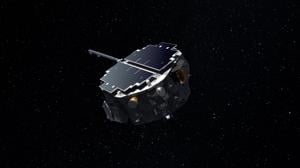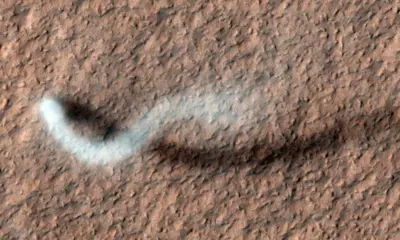Science
Blue Origin Set to Launch NASA’s Mars-Bound ESCAPADE Mission

Blue Origin is preparing for the launch of NASA’s Escape and Plasma Acceleration and Dynamics Explorers (ESCAPADE) mission, scheduled for no earlier than November 9, 2025. The mission will see two Mars-bound satellites lifted into space alongside a communications demonstration payload for Viasat. The launch will take place from Launch Complex 36 at Cape Canaveral Space Force Station, with liftoff targeted for 14:45 EST (19:45 UTC).
The New Glenn rocket, standing at 321 feet (98 meters), will ascend on a south-easterly trajectory. Blue Origin has slated an 88-minute launch window, during which the rocket’s first stage booster, aptly named ‘Never Tell Me the Odds,’ will attempt to land on the autonomous barge, Jacklyn. This recovery effort is critical as Blue Origin aims to reuse the booster for future missions.
Weather Forecast and Launch Details
The 45th Weather Squadron has reported a 65 percent chance of favorable weather for the launch. However, this probability decreases to 55 percent later in the launch window. Meteorologists have expressed concerns about potential cumulus clouds, lightning, and anvil clouds due to an approaching cold front, which could bring showers and possibly severe thunderstorms in the afternoon.
According to launch weather officers, “As the front approaches the region from the northwest, there will be enough moisture in place for showers to form ahead of and along the front.” They also noted a small chance of thunderstorm wind gusts reaching 80 feet per second on Sunday afternoon.
Following the first stage burn, the New Glenn rocket will perform two burns of the BE-3U engines on its upper stage before deploying the twin ESCAPADE satellites approximately 33 minutes after liftoff. The satellites, named ‘Blue’ and ‘Gold,’ are housed within the rocket’s payload fairings, which were sealed on October 31, 2025.
Mission Objectives and Collaborations
The ESCAPADE mission aims to deepen the understanding of Mars’ magnetosphere and its interactions with space weather, which could provide insights into the planet’s atmospheric history. This scientific endeavor is led by NASA’s Goddard Space Flight Center in conjunction with the University of California, Berkeley. The project also involves collaboration with Rocket Lab, Advanced Space, Embry-Riddle Aeronautical University, and Northern Arizona University.
Joseph Westlake, NASA Heliophysics Director, expressed enthusiasm for the mission, stating, “Really excited to see NASA’s Heliophysics’ first mission to Mars and being able to deliver that space weather information that will hopefully help as humanity expands out into the cosmos.”
Initially proposed as the Mars Ion and Sputtering Escape Network (MISEN) in October 2016, the project evolved into ESCAPADE by July 2018. In June 2019, NASA selected it as one of three finalists for its Small, Innovative Missions for Planetary Exploration (SIMPLEx) program, designed for missions with elevated risk tolerance and accelerated timelines.
Christophe Mandy of Rocket Lab highlighted the challenges of the tight schedule, noting, “We had three-and-a-half years to make two satellites to go to Mars. A typical timeline for a Mars mission is a decade.”
The ESCAPADE spacecraft, designed on Rocket Lab’s Explorer satellite bus, boasts a high mass fraction of fuel, nearly 70 percent, making it suitable for missions requiring significant delta-V. The spacecraft will remain in Earth orbit for approximately a year before embarking on a 10-month journey to Mars, with the Mars orbit insertion burn expected in September 2027.
As the launch date approaches, the global community eagerly anticipates the next phase in humanity’s exploration of Mars. The ESCAPADE mission promises to shed light on the Red Planet’s atmospheric dynamics, contributing to our understanding of its evolution and future explorations.
-

 Technology5 months ago
Technology5 months agoDiscover the Top 10 Calorie Counting Apps of 2025
-

 Health2 months ago
Health2 months agoBella Hadid Shares Health Update After Treatment for Lyme Disease
-

 Health3 months ago
Health3 months agoErin Bates Shares Recovery Update Following Sepsis Complications
-

 Technology4 months ago
Technology4 months agoDiscover How to Reverse Image Search Using ChatGPT Effortlessly
-

 Technology1 month ago
Technology1 month agoDiscover 2025’s Top GPUs for Exceptional 4K Gaming Performance
-

 Technology2 months ago
Technology2 months agoElectric Moto Influencer Surronster Arrested in Tijuana
-

 Technology5 months ago
Technology5 months agoMeta Initiates $60B AI Data Center Expansion, Starting in Ohio
-

 Technology5 months ago
Technology5 months agoRecovering a Suspended TikTok Account: A Step-by-Step Guide
-

 Health4 months ago
Health4 months agoTested: Rab Firewall Mountain Jacket Survives Harsh Conditions
-

 Lifestyle5 months ago
Lifestyle5 months agoBelton Family Reunites After Daughter Survives Hill Country Floods
-

 Technology4 months ago
Technology4 months agoHarmonic Launches AI Chatbot App to Transform Mathematical Reasoning
-

 Technology3 months ago
Technology3 months agoUncovering the Top Five Most Challenging Motorcycles to Ride





















